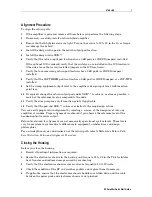
2
STARLINE
RF Amplifier Quick Start Guide
Installing the Coaxial Cables
Connections to the housing are made using standard KS-type housing port entry connectors.
Pin-type connectors with a nominal center conductor diameter of 0.067 inches are required. The
following table provides the center conductor pin length for the various amplifiers:
Amplifier models
Pin length (inches)
BLE*/*, MB*/*,
BT*/*, MBE*/*
1.50 minimum to 1.65 maximum
Pin
length
Use a torque wrench or Phillips screwdriver to tighten the center conductor seizure screw to a
torque of 12 in-lbs.
Powering the Amplifier
For optimal operation, verify that the ac input from the feederline to the power supply is
between 38 and 90 Vac (rms) with a line frequency of 50 or 60 Hz. The waveshape of the input
voltage must be quasi-squarewave.
The power supply provides the additional feature of a two position (
LO
and
HI
) selector that sets
the
startup voltage
of the power supply. The startup voltage is 38 Vac for the
LO
position and
55 Vac for the
HI
position. All units are shipped with the selector set in the
LO
position. The
LO
position is used with 60 Vac systems where 38 Vac startup voltage is required. For systems
operating at 90 Vac, the selector can be in the
LO
or
HI
position. Note that changing the selector
does not change the upper voltage limit but affects only the startup voltage. The voltage selector
should be switched only if the power supply approaches its maximum load rating.
There is no damage to the amplifier if the jumper is not changed. However, changing the jumper
ensures that the dc supply does not turn on until the proper input voltage level is reached —
either 38 Vac or 55 Vac. This prevents excessive loading of the
system
power supply during
turn-on after a system shutdown.
DANGER!
Voltages up to 90 Vac are accessible. To avoid a shock hazard, confirm that the STARLINE amplifier is not powered
before removing the cover or replacing the fuses.
To power the amplifier:
1
Set the power supply jumper for 90 Vac operation if required by your system.
2
Determine which fuses should be installed to route power to the appropriate ports.
3
Verify that the power supply output voltage is
+
24 Vdc.


























